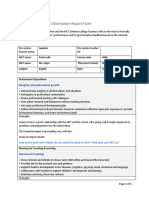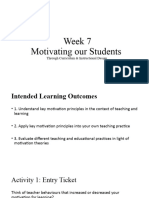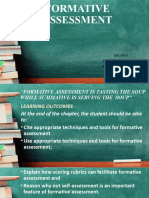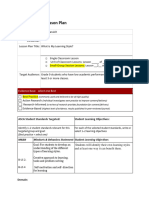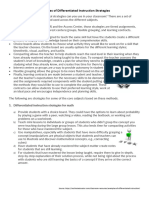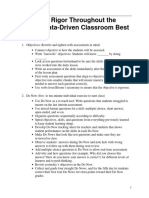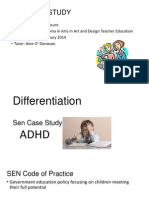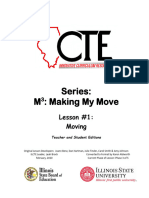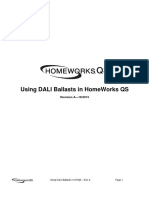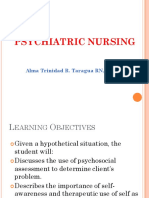RampIndividualLessonPlanMod4
RampIndividualLessonPlanMod4
Uploaded by
breona.bryant11Copyright:
Available Formats
RampIndividualLessonPlanMod4
RampIndividualLessonPlanMod4
Uploaded by
breona.bryant11Copyright
Available Formats
Share this document
Did you find this document useful?
Is this content inappropriate?
Copyright:
Available Formats
RampIndividualLessonPlanMod4
RampIndividualLessonPlanMod4
Uploaded by
breona.bryant11Copyright:
Available Formats
Lesson Plan
School Counselor: Lisa Moore
Lesson Plan Title: Everyday Matters-
Single Classroom Lesson
Unit of Classroom Lessons: Lesson _____ of _____
Small-Group Session Lessons: Lesson _____ of _____
Target Audience: 7th Grade- Adaptable for 9-12
Evidence Base:
Best Practice (commonly used and believed to be of high quality)
Action Research (individual investigates own practice to improve content/delivery)
Research-Informed (a review of research provides foundation for content/delivery)
Evidence-Based (highest level of evidence, results published in peer-reviewed journal)
ASCA Student Standards Targeted: Student Learning Objectives:
Identify 1–2 student standards relevant for this For each of the selected student standards, write or
targeted group and goal: select 1–2 learning objectives
(Best practice = select one)
M&B# Mindsets & Behaviors Statement Student Learning Objectives
Student(s) will:
M 1. Positive attitude toward work and 1. Define chronic absenteeism.
learning. 2. Understand the connection between
B-LS 4. Self-motivation and self-direction attendance and long term academic and
for learning. professional success.
B-LS 10 Participation in enrichment and 3. Identify how attendance is impacted by
extracurricular activities. participation in extracurricular activities
B- SMS 1. Responsibility for self and actions. and learn current options for
B- SMS 6. Ability to identify and overcome participation.
barriers. 4. Recognize barriers to attendance.
B- SS 3. Positive relationships with adults to 5. Recognize potential solutions to
support success. attendance barriers.
6. Identify staff available to share
attendance barriers with.
7. Acknowledge ways individuals can take
ownership and improve attendance.
Updated, June 2021
Materials:
• Laptop and projection to display Google Slides Cherry Lane Attendance Lesson
Slideshow
• Pre and post assessment copies and google form link sent to students.
Cherry Lane Attendance Lesson Pre-Assessment Form
Cherry Lane Attendance Lesson Post-Assessment Form
• Sometimes/Always/Never Icebreaker sheets for placement throughout the room,
Sometimes/Always/Never Signs
• Group activity task cards Cherry Lane Attendance Lesson Group Activity Task Cards. Pre-
cut and laminated and placed into 4 groups. 1 card from each category into each group.
• Blank ½ sheets of paper
• Pens and pencils
• Clubs and organizations list Cherry Lane Clubs and Organizations List
Describe how you will:
Introduce Lesson • Introduction of lesson will be a short discussion about school
Topic/Focus: transition and expectations for Cherry Lane School regarding
attendance.
• Completion of a pre-assessment using google forms. For students
without devices or who prefer handwritten documents, paper
forms will be provided. Cherry Lane Attendance Lesson Pre-
Assessment Form
• Complete short ice breaker activity. 3 signs will be placed around
the classroom identifying “Sometimes, Always, Never.” Students
will then be asked a series of questions that are also listed on the
PowerPoint presentation and asked to identify their feelings
about the question as sometimes, always, never. If the room
permits, students will walk to the designated area to answer the
question. If not they will remain in their seats and if they select
“never” they will stay seated, “sometimes” will stand, and
“always” stand with their hands raised in the air.
Sometimes/Always/Never Signs
Communicate the Students will learn school attendance definitions and the importance of
Lesson Objective: regular attendance, understanding the connection between attendance
and academic performance. They will identify and begin to problem
solve barriers to attendance and understand the importance of school
engagement and extra-curricular activity options at Cherry Lane.
Teach Content: Google slides will be presented to teach content. Definition of various
attendance terms will be reviewed as well as the impacts of attendance
performance. Barriers to attendance and the value of school
Updated, June 2021
engagement will also be reviewed. Transition into practical application of
these ideas. Cherry Lane Attendance Lesson Slideshow
Practice Content: • Students will be placed into 4 groups to complete group activity,
desks organized as such if possible. Each group will be given 5
cards to complete during the activity; 1 card from each category
(Act it out, imagine if, sketch it out, discuss, and true false).
Provide 8-10 minutes for group to answer and discuss every card.
Rotate cards with another group depending on time allotment,
ideally 2-3 rotations. Place blank half sheets of paper and pens on
desks.
Cherry Lane Attendance Lesson Group Activity Task Cards.
• Counselor will rotate throughout the groups asking questions and
prompting engagement as needed.
• Students return to seats and debrief activity.
• Suggestion if needed: teacher will read cards to group members,
groups will be placed in circles on the floor instead of at a desk,
remove or eliminate specific task cards that do not fit the needs
of the group.
Summarize/Close: • Review of concepts and discussion of tips and tricks to improve
attendance. Focus on reaching out to staff and faculty for help as
well as joining groups for engagement.
• Hand out list of current clubs and organizations. Cherry Lane
Clubs and Organizations List
• Complete post-assessment google form. Cherry Lane Attendance
Lesson Post-Assessment Form
Data Collection Plan – For multiple lessons in a unit, complete this section only once for the unit.
Participation Data Plan:
Anticipated number All 7th grade students, estimated 142
of students:
Planned length of 30-45 mins.
lesson(s):
ASCA Student Standards Data Plan:
For each lesson/unit/small group, school counselors will administer pre-/post-assessment aligned with the selected
ASCA Student Standards and student learning objectives.
Pre-/Post-Assessment items are:
1. School attendance impacts the way students perform on tests and their grades.
a. True
b. false
2. How many days does a month does a student need to miss to be chronically absent?
Updated, June 2021
a. 2
b. 3
c. 4
d. 5
3. What are some barriers to attendance that students may encounter throughout the
school year?
4. Participating in a school club or organization can help improve attendance.
a. True
b. false
5. I feel comfortable going to a teacher or staff member to help me problem solve barriers
to attendance and get caught up when I miss school.
a. Agree
b. Disagree
Students will leave lesson with an understanding of what chronic absenteeism is and how it
impacts performance. They will identify barriers to attendance and begin to problem solve
them as well as identify individuals who can help them and organizations, they can engage in.
Outcome Data Plan: (choose one and describe specific data point to compare)
Examples:
Achievement: School counselor will compare reading levels of students before and after delivery of lesson.
Attendance: School counselor will compare number of absences last year to this year.
Discipline: School counselor will compare total number of disciplinary reports for peer-on-peer conflict first quarter
with second quarter
Achievement (describe):
Attendance (describe): By May 2023, 7th grade chronic absenteeism will be reduced by 5%
and club participation will increase by 10%. Minority student chronic absenteeism for 7th grade
students will reduce by 10%. As students matriculate, continued impact on attendance will
improve school wide chronic absentee data.
Discipline (describe):
Follow-Up Plans
Explain your plan for students who missed the lesson.
We will provide the lesson during 7th grade resource class to ensure access to all. For those
who miss, an online version of the course will be available with videos for viewing in addition to
the group activity information. The lesson will be posted on the students online learning
platform to ensure students and families have access. It may also be shared with other grades
as requested or needed.
Explain your plan for students who did not demonstrate mastery on the pre-/post-assessment
of student standards (M&B)/student learning objectives.
After reviewing pre/post data results outliers will be identified and additional support
determined on a case-by-case basis. Students may be referred to the Attendance Check in
Small Group or individual counseling. Additional courses in overcoming barriers and self-
awareness, self-advocacy and diversity/inclusion may also be provided.
Updated, June 2021
Updated, June 2021
You might also like
- 4DRC 4D-V4 Richie User ManualDocument9 pages4DRC 4D-V4 Richie User ManualMarco Antonio Esquivel Talavera67% (3)
- D9102 User Manual: 1. USB Interface 2. SIM Card 3. Modem Cap 4. Guide Light 5. Cover of SIM CardDocument5 pagesD9102 User Manual: 1. USB Interface 2. SIM Card 3. Modem Cap 4. Guide Light 5. Cover of SIM CardInussi Mitas Júnior100% (1)
- 5 Steps To Prepare For Collaborative LearningDocument7 pages5 Steps To Prepare For Collaborative LearningfaezzahNo ratings yet
- Dol Lecture Etp110-410Document26 pagesDol Lecture Etp110-410api-249799367No ratings yet
- Sarah King Lesson Plan W4Document4 pagesSarah King Lesson Plan W4Sarah KingNo ratings yet
- Year 7 teacher support resourceDocument12 pagesYear 7 teacher support resourcestgregNo ratings yet
- Obs 2Document5 pagesObs 2JwaherNo ratings yet
- Module 4Document17 pagesModule 4Madhuri KarnewarNo ratings yet
- Module 4Document17 pagesModule 4Madhuri KarnewarNo ratings yet
- Lesson Plan 4Document4 pagesLesson Plan 4api-454030864No ratings yet
- Classroom ManagementDocument42 pagesClassroom Management23gsit00002No ratings yet
- Week 7 Final Motivating StudentsDocument109 pagesWeek 7 Final Motivating StudentssunnylamyatNo ratings yet
- Lesson Plan 5-CombinedDocument21 pagesLesson Plan 5-Combinedapi-663783105No ratings yet
- CCSS - ELA-LITERACY - RL.3.2 Recount Stories, Including Fables, Folktales, and MythsDocument5 pagesCCSS - ELA-LITERACY - RL.3.2 Recount Stories, Including Fables, Folktales, and Mythsapi-353115054No ratings yet
- Engaging Students in Learning: Comprehensive Induction ProgramDocument18 pagesEngaging Students in Learning: Comprehensive Induction Programgotu123No ratings yet
- 2010 Annual Challenging GiftedDocument8 pages2010 Annual Challenging Giftedapi-413748610No ratings yet
- MOD 4 RAMP Lesson Plan (COMPLETED)Document5 pagesMOD 4 RAMP Lesson Plan (COMPLETED)breona.bryant11No ratings yet
- Formative AssessmentDocument14 pagesFormative Assessmentkmiboy976No ratings yet
- Learning Notebook - Erin BurnsideDocument32 pagesLearning Notebook - Erin Burnsideapi-727891576No ratings yet
- Internship Study Skills Lesson 2 PDFDocument7 pagesInternship Study Skills Lesson 2 PDFapi-700080126No ratings yet
- Active Learning in The Science ClassroomDocument24 pagesActive Learning in The Science ClassroomlailaiketongNo ratings yet
- Chris Lesson 4 Observation FeedbackDocument3 pagesChris Lesson 4 Observation Feedbackapi-314065383No ratings yet
- Group 1-Study SkillsDocument10 pagesGroup 1-Study Skillsapi-392892651No ratings yet
- t3l RJG CommentsDocument4 pagest3l RJG Commentsapi-242609249No ratings yet
- Designing Integrated Learning For StudentsDocument8 pagesDesigning Integrated Learning For StudentsriddockNo ratings yet
- Assessment PagesDocument7 pagesAssessment Pagesapi-361348967No ratings yet
- Examples of Differentiated Instruction StrategiesDocument3 pagesExamples of Differentiated Instruction StrategiesvdesperceNo ratings yet
- Field Study1 - Ep 7.2Document12 pagesField Study1 - Ep 7.2Mariya Quedz100% (2)
- March 20, 2023 (Monday)Document7 pagesMarch 20, 2023 (Monday)Edralyn Joy OrbigoNo ratings yet
- Explicit Teaching Framework Lac Session TopicDocument50 pagesExplicit Teaching Framework Lac Session TopicGodgiven Blessing100% (3)
- Am Small Group PlanDocument3 pagesAm Small Group Planapi-448951745No ratings yet
- Collaborative LearningDocument34 pagesCollaborative Learningmelody magahis67% (3)
- Interactive Classroom Activities - Sheridan Center - Brown UniversityDocument6 pagesInteractive Classroom Activities - Sheridan Center - Brown UniversitySharina ObogNo ratings yet
- Week 2 Artifact 2Document13 pagesWeek 2 Artifact 2api-463700896No ratings yet
- Employing Interactive Classroom Activities in Promoting Fairness andDocument20 pagesEmploying Interactive Classroom Activities in Promoting Fairness andDorothy Diaz MagonciaNo ratings yet
- Dda 2Document6 pagesDda 2api-338163098No ratings yet
- Reading Group Lesson PlanDocument3 pagesReading Group Lesson Planapi-477255988No ratings yet
- Adaptations Extensions Modifications and Strategies PDFDocument26 pagesAdaptations Extensions Modifications and Strategies PDFLGNo ratings yet
- Simon Irin Cardboard Relief Sculpture Lesson PlanDocument16 pagesSimon Irin Cardboard Relief Sculpture Lesson Planapi-338776600No ratings yet
- Cep Lesson Plan 2Document9 pagesCep Lesson Plan 2api-690650522No ratings yet
- Academic Success Group LessonsDocument20 pagesAcademic Success Group Lessonsapi-341978441100% (1)
- MNO Mini Unit AssignmentDocument36 pagesMNO Mini Unit Assignmentapi-299713215No ratings yet
- Session 2 - Lesson PlansDocument22 pagesSession 2 - Lesson PlansShahzeb Azam - 58806/TCHR/BCHCNo ratings yet
- CR GUILLERMO FeedbackingDocument28 pagesCR GUILLERMO FeedbackingCretchel GarnaceNo ratings yet
- School Counseling & Career Guidance: Grades K-2Document16 pagesSchool Counseling & Career Guidance: Grades K-2Amanda-KoonsNo ratings yet
- Summarizing: in Upper ElementaryDocument30 pagesSummarizing: in Upper Elementaryapi-600626782No ratings yet
- Increasing Rigor Throughout The LessonDocument4 pagesIncreasing Rigor Throughout The LessonMarquise HinesNo ratings yet
- Sen Case StudyDocument29 pagesSen Case Studyapi-254292080No ratings yet
- Teaching Multi GradeDocument7 pagesTeaching Multi GradeLG Mica Adriatico GuevarraNo ratings yet
- Classroom Assessment ToolsDocument69 pagesClassroom Assessment ToolsSyeda Raffat HassanNo ratings yet
- Cep Lesson Plan 2-23Document10 pagesCep Lesson Plan 2-23api-630895186No ratings yet
- EDUC 105A-Group 1 Lesson PlanDocument12 pagesEDUC 105A-Group 1 Lesson PlanRutchell Mata DologuinNo ratings yet
- Scn610-Schoolcounselinglessonplantemplate-Hp 1Document6 pagesScn610-Schoolcounselinglessonplantemplate-Hp 1api-722055308No ratings yet
- Ass Classroominstructionthatworksgroup MorazanoDocument37 pagesAss Classroominstructionthatworksgroup MorazanoYasmeen JafferNo ratings yet
- Fkan DJmcksDocument18 pagesFkan DJmcksHazniNo ratings yet
- Designing, Facilitating and Assessing Problem-Based Learning Lessons in K-12 ClassroomDocument8 pagesDesigning, Facilitating and Assessing Problem-Based Learning Lessons in K-12 ClassroomParuntu PatriceNo ratings yet
- 2324VTC - Creating Stimulating Classroom - Staff - KennethDocument70 pages2324VTC - Creating Stimulating Classroom - Staff - KennetharetkusuNo ratings yet
- Basic Training Starting The School Year Right - Complete UnitDocument44 pagesBasic Training Starting The School Year Right - Complete UnitBrian Thomas100% (1)
- Lesson Plan English Sekolah Amanah 2Document3 pagesLesson Plan English Sekolah Amanah 2Yunus RazaliNo ratings yet
- SC Lesson1 Moving Teacher StudentDocument34 pagesSC Lesson1 Moving Teacher Studentjen9001No ratings yet
- GCB Syllabus May 2011Document29 pagesGCB Syllabus May 2011Pin KisNo ratings yet
- Prosafe Rs Installation ProcedureDocument306 pagesProsafe Rs Installation ProcedureNiyi AdetunjiNo ratings yet
- MatLab and Solving EquationsDocument170 pagesMatLab and Solving EquationsJulia-e Regina-e AlexandreNo ratings yet
- Using Dali in HwqsDocument18 pagesUsing Dali in HwqsRadhi HirziNo ratings yet
- Sprint - Volte Kpi'sDocument3 pagesSprint - Volte Kpi'sSreeNo ratings yet
- The Tetragrammaton: in Her Book, in Awe of Thy Word, Gail Riplinger Highly Recommended Books by KabbalistsDocument16 pagesThe Tetragrammaton: in Her Book, in Awe of Thy Word, Gail Riplinger Highly Recommended Books by Kabbalistsgrace10000No ratings yet
- Empowerment of Women: A Reality or A Myth: Dr. Daisy Changmai & Monmi GohainDocument13 pagesEmpowerment of Women: A Reality or A Myth: Dr. Daisy Changmai & Monmi GohainTJPRC PublicationsNo ratings yet
- How Much Homework Does Kumon GiveDocument5 pagesHow Much Homework Does Kumon Giveafmtjbyaz100% (1)
- Mca - V20pca104 - Ec2332251010489Document3 pagesMca - V20pca104 - Ec2332251010489Tushar ChaudharyNo ratings yet
- Psychiatric Nursing: Alma Trinidad R. Taragua RN, RM, MANDocument63 pagesPsychiatric Nursing: Alma Trinidad R. Taragua RN, RM, MANShy Dela PuertaNo ratings yet
- Lesson 9 Practice Problem #2 3T AY1920-1Document2 pagesLesson 9 Practice Problem #2 3T AY1920-1lancematthewteNo ratings yet
- XACA08H7: Product Data SheetDocument3 pagesXACA08H7: Product Data SheetSajeev JacobNo ratings yet
- 09 Blindness Prevention Role of Civil Society OrganisationsDocument3 pages09 Blindness Prevention Role of Civil Society OrganisationsMwanja MosesNo ratings yet
- Untitled DocumentDocument8 pagesUntitled DocumentHajara FawaisNo ratings yet
- Ethical Theories in BusinessDocument14 pagesEthical Theories in BusinessSagar PatelNo ratings yet
- Fruit Jam & Jelly - Preparation1Document2 pagesFruit Jam & Jelly - Preparation1Iboyaima singhNo ratings yet
- Field Methods in Psych by PartnerDocument3 pagesField Methods in Psych by PartnerChin Dela CruzNo ratings yet
- English: Council For The Indian School Certificate ExaminationsDocument51 pagesEnglish: Council For The Indian School Certificate ExaminationsAsh UrlopeNo ratings yet
- Drying GingerDocument10 pagesDrying GingerWinda Putri HaryantiNo ratings yet
- Inspired Word of GodDocument18 pagesInspired Word of GodBradford McCallNo ratings yet
- Port Monitor-MirrorDocument16 pagesPort Monitor-MirrorHai LeNo ratings yet
- Berkhan's Leangains PDFDocument1 pageBerkhan's Leangains PDFferncaz95No ratings yet
- FrenchportculdocDocument2 pagesFrenchportculdocapi-242027531No ratings yet
- Generational Curses - Are You CursedDocument10 pagesGenerational Curses - Are You CursedSuraj GeorgeNo ratings yet
- Types of MalwareDocument13 pagesTypes of Malwarejigisha kiran shahNo ratings yet
- JD Medical Assistant-Clinical OfficerDocument2 pagesJD Medical Assistant-Clinical Officerpeter mulilaNo ratings yet
- Retail Banking Report - Ayushi NairDocument15 pagesRetail Banking Report - Ayushi Nairjlu06233No ratings yet
- CCTV Camera Security CourseDocument6 pagesCCTV Camera Security Coursemwelwa mulenga chamataNo ratings yet






